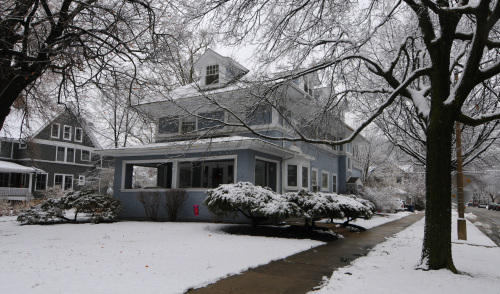In the world of legacies, Oak Park, Illinois, has a couple of biggies.
The brilliant, scandalous architect Frank Lloyd Wright spent the first 20 years of his career there, leaving the western suburb with the world’s largest collection of buildings he designed.
Then there’s the brilliant, scandalous writer Ernest Hemingway, who was born in Oak Park and spent nearly his first 20 years there, writing his earliest pieces, gaining an appreciation for nature and dreaming of worldly adventures.
Frank Lloyd Wright’s home and studio is a popular tourist attraction that draws 80,000 visitors a year.
Hemingway’s boyhood home is essentially a three-flat that officially was put up for sale last week after an effort to convert it into “an international community center” unraveled.
That development may be nothing more than another example of an anemic economy, or it may shed light on precisely where the literary giant and Nobel Prize winner stacks up, at least locally, against Wright, who some say shifted the course of 20th-century architecture.
“It was a great plan,” said John Berry, chairman of the Ernest Hemingway Foundation of Oak Park, which owns the slate-blue, three-story stucco home. “But it was a bad market for raising money.”
Designed in part by Hemingway’s mother, Grace, the 4,200-square-foot home has been something of a living monument since at least 1974, when the Historical Society of Oak Park and River Forest placed a plaque in the front yard. The last Hemingway to live in the home, Grace, vacated it in 1936, eight years after her husband committed suicide in their second-floor bedroom.
The next owners carved it into three apartments, and that’s the way it stayed. In 2001 the Hemingway Foundation borrowed $420,000 and, aided by a $100,000 gift from the village of Oak Park, bought the home for $520,000, Berry said.
Eight years later, the foundation and Dominican University in River Forest agreed on a $1.5 million plan to transform it into “a unique and dynamic cultural center to educate citizens of the world for the 21st century,” according to a plan developed by Dominican.
 |
The boyhood home of Ernest Hemingway in Oak Park, Illinois, is on the market for $525,000. (Chicago Tribune/MCT) |
That vision included rebuilding the home’s original first-floor “music room,” removed years ago, and using it for displays, performances, “salons and conversations.” The second and third floors were to serve as “a residential retreat for scholars and artists.”
The agreement between the university and foundation, signed July 1, 2009, called for Dominican to lease and maintain the property for two years while fundraising grew. If all went well, the university would buy the home and continue working with the Hemingway Foundation on its use.
But the plan, undertaken in the middle of the worst economic downturn since the Great Depression, failed to gain momentum.
“We had a lot of great conversations,” said Amy McCormack, Dominican senior vice president of finance and administration. “We certainly had a good team, (and) we had a lot of interest in the concept.”
Funding the concept, however, was another story. Hemingway’s descendants offered no financial support, Berry said. After getting a state grant that helped pay for a new roof, the fundraising group decided against appealing to Illinois for financial support.
The economic climate dashed their dreams. So when the loan came due in the summer, the foundation persuaded bankers to grant an extension for a few months, then officially placed the home for sale on Wednesday at an asking price of $525,000. Since then, traffic has been brisk, said Steve Scheuring, listing agent for the home.
“We live with this Hemingway thing all the time,” added Scheuring, a fourth-generation Oak Park resident. “And, so far the Hemingway thing is very nice.”
But, Scheuring added, the handful of prospective buyers he has shown the house to “weren’t interested in buying it for the Hemingway thing. I think they’re interested in buying it for the square footage and they’re interested in buying it because it’s a really cool house.”
History can be cruel, but so can the real estate market. The Hemingway house, where he lived from age 7 to 17, would appear to be a bargain even with the depressed real estate market , which raises another question: How do you determine the value of the place where one of America’s most influential writer penned his first stories?
“Right now,” Scheuring said, “the buyer is going to have to tell us that.”
Also lurking in the background is the intangible reality that, at least in Oak Park, Hemingway’s reputation stands in the shadow of the famous architect, who left his unmistakable imprint on the streets.
Rachel Weaver, co-owner of The Book Table in the village’s downtown, said Hemingway’s Oak Park roots are often overshadowed by Wright’s visual presence.
“Certainly Frank Lloyd Wright is a bigger tourist draw,” Weaver said. “Visually, his presence permeates Oak Park more than Hemingway. When you have so many great Frank Lloyd Wright homes to go and see, it’s the more obvious attraction.”
The local Hemingway foundation, however, has restored the writer’s Oak Park birthplace, which is open to the public. The foundation also runs the Ernest Hemingway Museum, an intriguing mix of Hemingway artifacts and related memorabilia, a few blocks from the birthplace
Berry said the architect’s and the writer’s legacies both “draw well, but built environments tend to draw bigger crowds than the written word that must be read and absorbed. For architects, the buildings are the work, they are visible and tactile; it’s different for writers. It’s not about the building. It’s about the writing.”
Some of the writing Hemingway composed in the house likely was done in an area on the third-floor that faces south, Hemingway’s room until he graduated from high school and left for a reporting job at the Kansas City Star.
He returned for a few months in 1919 to recuperate from wounds suffered as an ambulance driver in Italy and a broken heart ― a casualty of the end of his romance with a nurse in Europe. That relationship became the inspiration for “A Farewell to Arms,” Hemingway’s classic novel of war. That book and 19 other works by him were made into movies.
He and Wright went on to lead lives some would consider notorious. Married four times, Hemingway battled alcoholism and mental illness, committing suicide in 1961. Wright, while living and working in Oak Park, deserted his wife and six children for the wife of a client. That woman, Martha “Mamah” Borthwick Cheney, was murdered in 1914.
Hemingway’s persona certainly fueled his popularity and probably explains why Kathy Fitzgerald, who lived on the first floor of the Hemingway home from 1977 until November 2010, recalled “lots of interesting people would stop by” over the years.
“Giant tour buses” were an occasional sight, she said, as were individuals ― many from other countries ― who simply wanted to walk inside the place.
That popularity, Fitzgerald said, suggests that Hemingway’s legacy is wider than Wright’s.
“I hope they find somebody to salvage everything,” she said. “We’re keeping our fingers crossed.”
By Ted Gregory
(Chicago Tribune)
(MCT Information Services)








